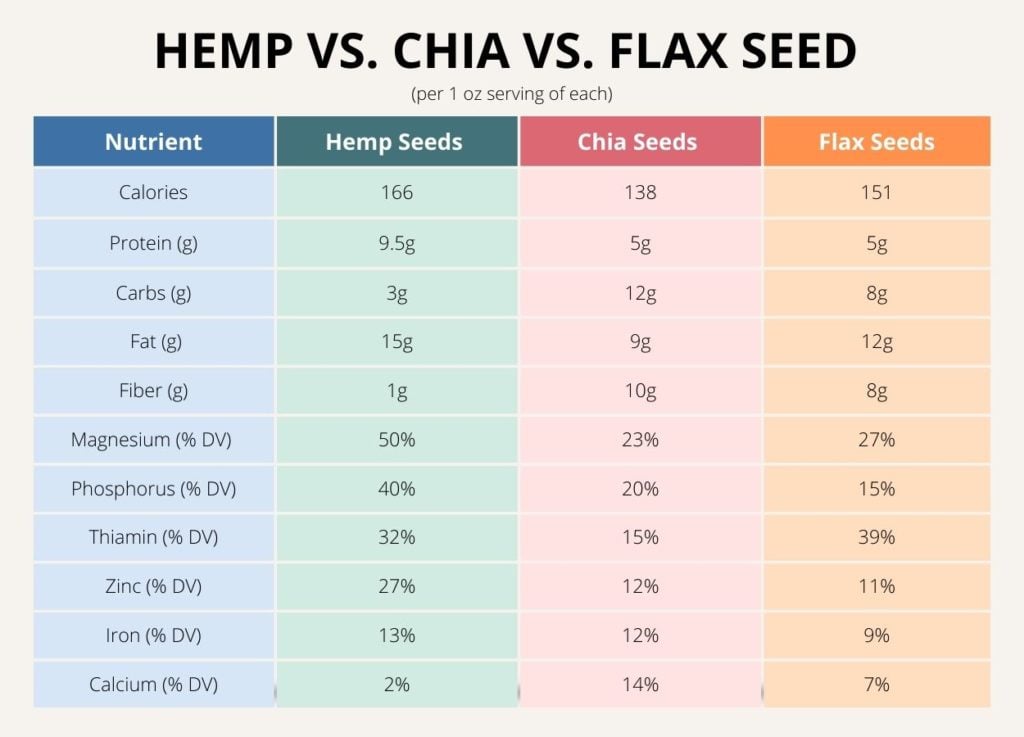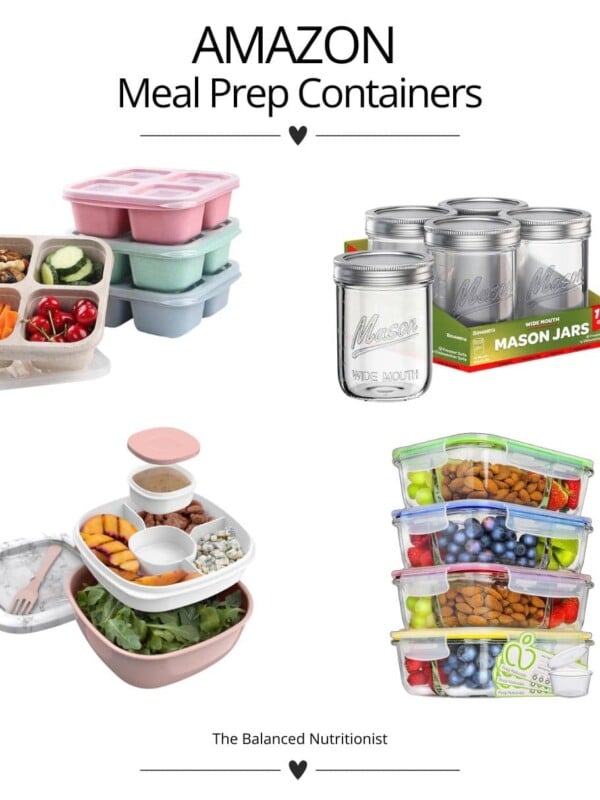This post may contain affiliate links. Please read our disclosure policy.
Hemp seeds, chia seeds and flax seeds are tiny edible seeds that pack a powerful nutritional punch. They’re so nutrient-dense that they’re often referred to as “super seeds”.
As a Registered Dietitian, I’m always looking for simple ways to help you add more nutrients into your diet. Eating more of these seeds is an easy way to add tons of nutrition and enjoy some of the health benefits that come with them.
But, how do they compare? Which is the healthiest? Let’s get into the facts!
Hemp vs Chia vs Flax Seeds Chart
Here’s a quick overview of the nutritional profiles of hemp seeds, chia seeds and flax seeds (1).

Hemp seeds vs chia seeds vs flax seeds: let’s compare!
If you’re interested in incorporating more seeds into your diet, you may be trying to figure out which one is the best for you. Let’s jump into the nutritional benefits and differences.
Hemp seeds
Hemp seeds, also known as hemp hearts, have a mild and nutty flavor with a crunchy texture. Compared to chia and flax seed, they’re:
- Slightly more calorie dense
- Highest in fat
- Highest in protein at 10 grams of protein per serving
- Lowest in fiber
One serving (about 3 tablespoons of hemp seeds) also offers 50% of the daily value (DV) of magnesium, 13% DV iron, and is a good source of phosphorus, thiamine and zinc.
Don’t be worried about that fat content- hemp hearts are rich in omega-3 fatty acids, AKA healthy polyunsaturated fats that can support cardiovascular health, lower your risk of stroke and may even have protective roles in cancer and support your brain health (2, 3).
Another major difference is that unlike chia seeds and flax seeds, hemp seeds don’t absorb water. They maintain their crunchy consistency and have a more nut-like texture. You can use hemp seeds to add some crunch to toast, yogurt, or oats.
Chia seeds
Chia seeds are small round seeds with a crunchy texture. In terms of nutrition, chia seeds:
- Are the highest in fiber with 10 grams of fiber per 1 oz serving
- Have 5g of protein and 9g of heart-healthy fats.
- Are a good source of magnesium, phosphorus, and also contain 12% your daily value of iron.
If you’re looking for the highest fiber seed, chia seed might be the one for you. Because of the high soluble fiber content, it’s not surprising that research shows chia seeds to have beneficial effects on cholesterol levels (4).
Eating more fiber can also help support blood sugar levels, make you feel fuller, and support digestive health (5).
You may be wondering if chia seeds can help with weight loss, and the answer is- maybe! High fiber diets have been shown to support weight loss (6). With that said, maintaining a balanced diet and healthy lifestyle overall is most important for a healthy weight.
Chia seeds are also high in disease-fighting antioxidants. Specifically, chia seeds contain antioxidants that may have protective effects on your heart, liver, and anti-cancer benefits too (7). Like hemp and flax seeds, they’re rich in heart-healthy omega-3 fats.
Something super interesting about chia seeds is that they can absorb a ton of liquid (up to 10x their weight!). When mixed with liquids, they transform into a soft, gel-like texture. This makes them a great natural thickener for recipes like chia seed pudding and overnight oats!
Flax seeds
Flax seeds have a slightly nutty taste but do have a slightly more gritty texture compared with chia seeds and hemp seeds.
Nutritionally, ground flaxseeds are:
- A good source of omega-3 fats
- Pack 8g of fiber per serving
- A great source of magnesium
Flax seeds contain lignans, a type of phytoestrogen with antioxidant properties. that’s linked to lower risk of osteoporosis, heart disease and breast cancer (8).
Just like chia seeds, flax seeds can absorb liquids, making them a great choice for thickening recipes or making flaxseed pudding. You can even use flaxseed to replace eggs in recipes by making a flax egg.
Make sure you choose ground or milled flaxseed, though. The hard exterior of flaxseed in its whole form keeps all of its nutrients tucked away and our bodies can’t absorb them. The outer shell of whole seeds has to be broken to unlock all of the amazing nutrients inside.
Hemp seeds vs chia seeds vs flax seeds: the cliff notes
- Essential omega-3 fats: All three seeds are a good source of heart-healthy omega-3 fats (9).
- Plant-based protein: Hemp seeds have the highest protein content, but they’re all a source of plant-based protein.
- Fiber: Flax seed and chia seed are excellent sources of dietary fiber. Hemp seeds have fiber too, but less than the others.
- Antioxidants: They’re full of chronic disease-fighting antioxidants (10)
- Natural thickeners: Chia and ground flax can absorb water and act as a thickener, while hemp seeds cannot.
How to Eat Hemp seeds, Flax seeds, and Chia seeds
Sprinkled on oatmeal
Enjoy a tablespoon or two of these tiny seeds mixed into your favorite oatmeal dish to add a boost of nutrition.
In a smoothie
If you’re not a huge fan of the taste or texture of seeds, add them to your favorite smoothie.
In a yogurt or cottage cheese bowl
Sprinkle seeds on top of any yogurt or cottage cheese bowl. Fill your favorite breakfast bowl with yogurt or cottage cheese, berries, granola, and seeds for a high protein, high fiber and healthy fat combination.
In baked goods
Seeds make a great addition to muffins, pancakes and bread recipes, like these Banana Blueberry Muffins with chia seeds.
Which seed is the healthiest?
Hemp seeds vs chia seeds vs flax seeds….. which one’s the best?
As a Registered Dietitian I can honestly say: I can’t choose! It’s no surprise that you’ll find these popping up more in your local grocery stores. Chia seeds, hemp seeds and flax seeds are all super nutrient-rich and a good idea to add to your diet.
If you’re looking for a seed with more protein, hemp seeds are a great option. If you’re needing to bump up your fiber intake, go for the chia seeds.
If you want a seed that has a little bit of both, the flaxseed might be the best option. Or, you can combine all three and sprinkle a few tablespoons whenever you’re in the mood.
Regardless of which one you choose, you can feel confident knowing you’re adding a boost of disease-fighting, heart-healthy nutrients to your diet.
You might also be interested in:
5 Ways to Reset Your Metabolism
How Many Times Should You Eat A Day? A Dietitian’s Take
Why Do I Keep Eating After I’m Full? (And What To Do About It)














Great article! Thanks for the info and breaking it down so nicely 🙂
So glad you enjoyed it Sarah! Thank you for the feedback 🙂
I do not eat seafood, and can’t stand the “fishy burps” from Fish oil, so my Rheumatologist suggested these three seeds for anti-inflammatory reasons. Do you have any preference for this purpose?
Any will work! 🙂
Wow, this information was exactly what I needed. Well done!
thank you for this usefu information! 🙂
This is exactly the information I was looking for. Thank you!
You rock you Rockstar dietician, you!!! (My sweet dad wanted me to be a dietician so very much). I just didn’t think I’d have the patience for the schooling & I gather there’s a lot! Btw: circa late 60’s. Nutrients JUST started surfacing. I’ll never forget! In the kitchen with dad throwing bee pollen alfalfa sprouts beans & flaxseed & olive oil and celery NUTS and a WHOLE host of “stuff” in Every dish! I didn’t understand his huge bowl of berries & his yogurt maker. NOW I GET IT!!! My father respectfully had GORGEOUS thick white hair, Perfect teeth & UNWRINKLED no-pores GLOWING skin, no heart disease & “the Lowest cholesterol in Ventura county”! PERFECT cognition and Humor! (All up until he passed softly age 92). Oh yes ALOT of supplements thru the years too. He landed Parkinson’s but ALSO: “no bone loss amazing for his age”. Yes Miss Dietician keep your knowledge (presented to us laymen SO beautifully) – coming my only question is: Hospital food OFTEN laden with crap. WHY???